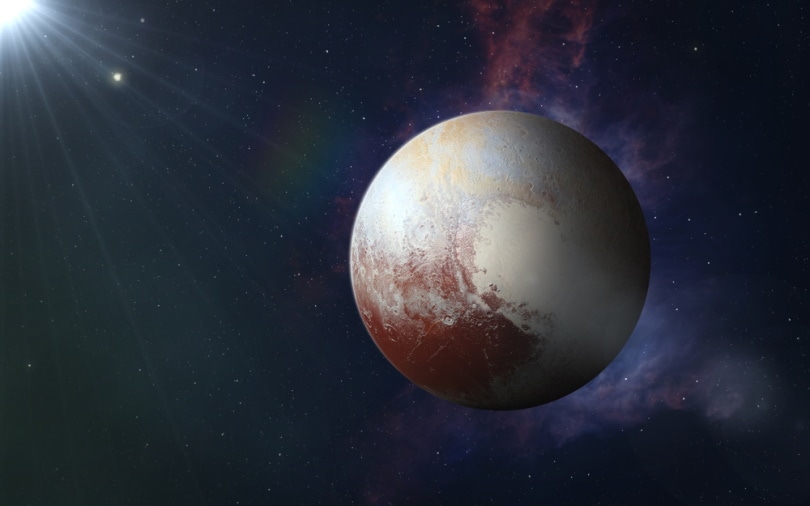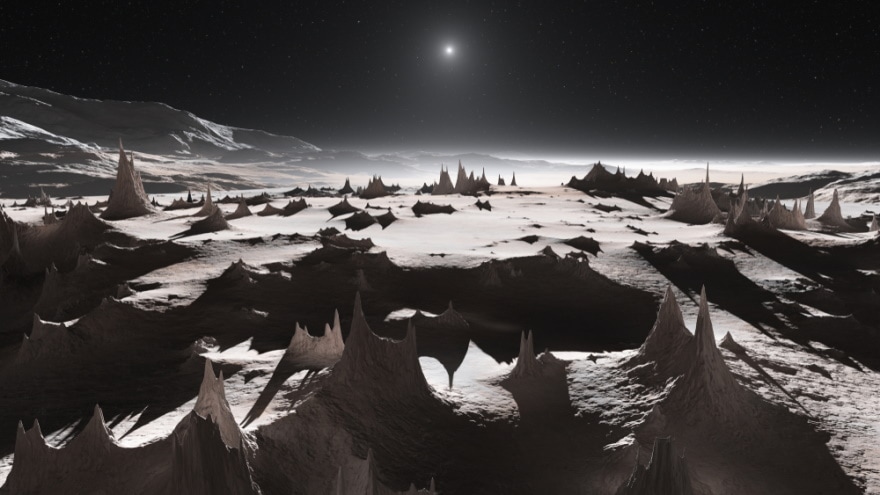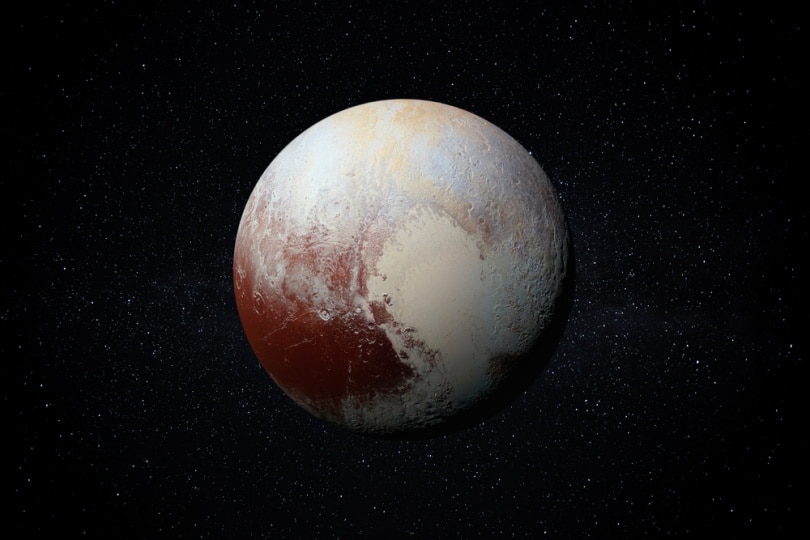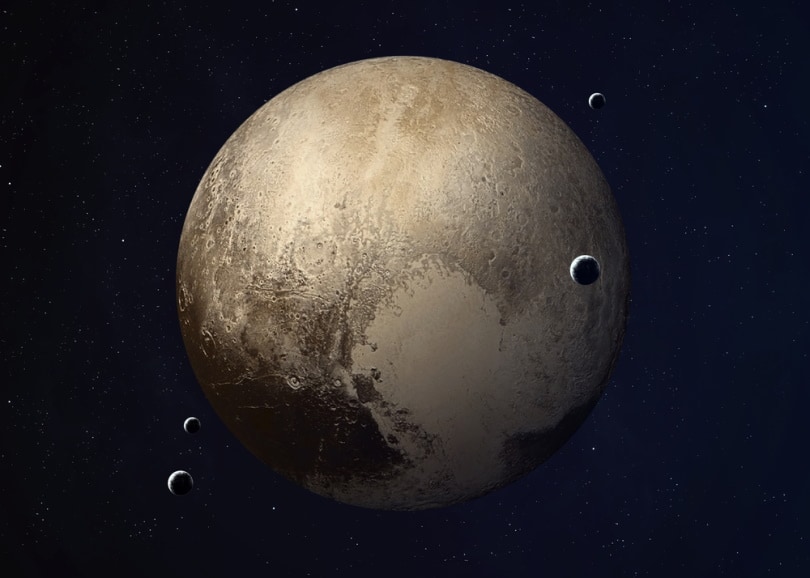How Cold Is Pluto? Exploring Pluto’s Atmosphere
Last Updated on

Being the smallest and farthest planet in the Solar System, Pluto has some pretty interesting facts you may not know about. For example, we all know Pluto is a cold planet, but how cold exactly? The dwarf planet can get as cold as -375°F to -400°F, depending on the time of year.
We may think Antarctica is pretty cold since its record lowest temperature is -137°F. Humans can only survive for 3 minutes at this temperature. However, when comparing this temperature to Pluto’s -375°F, life in Antarctica seems like a summer breeze.
While it’s not the coldest planet in our Solar System, it’s still pretty icy over Pluto. Now, the questions you’re probably wondering about are: What’s Pluto’s atmosphere like? Is it too cold for humans to survive? Is the planet colder than it should be?
Read on to find all these questions answered and explore deeper into the dwarf planet’s atmosphere.

General Description of Pluto
Pluto is a dwarf planet that is the ninth farthest from the Sun and even smaller than our moon on Earth. The planet was discovered in February of 1930 and is a breathtaking world of high mountains, icy air, blue skies, fiery snow, and spinning moons.
In addition, one year on Pluto is as long as 90,530 Earth days or 248.8 Earth years. Ever since its discovery, the planet has only completed one orbit around the Sun, which it was the closest to in the 1980s.

History
Pluto gained its name after an 11-year-old girl named Venetia Burney suggested it to her grandfather. He forwarded the recommendation to the Lowell Observatory that the planet should be named after the Roman god of the underworld.
The planet was initially discovered as the ninth planet from the Sun but got reclassified as a dwarf planet after further investigation into the distant Kuiper Belt.
Size and Distance
Pluto has a radius of only 715 miles, and it’s about half the width of the United States. So, here’s a cool way to know the size of this icy dwarf: if Pluto was as big as a popcorn kernel, Earth would be the size of a nickel.
This planet is the farthest away from our star, the Sun, with an average distance of 3.7 billion miles. That is 39 times as far as Earth’s distance from the Sun. As a result, Pluto is pretty dark and gloomy most of the day, as sunlight takes about 5.5 hours to reach the planet.
Atmosphere
Now, let’s talk about Pluto’s icy atmosphere and surface. Its atmosphere mainly consists of molecular nitrogen, but some methane and carbon monoxide traces are also visible. This is because ice instantly sublimates into gas when the planet approaches the sun during its orbit.
In other words, the planet’s atmosphere can be described as a tenuous layer of gases. On the planet’s surface, nitrogen, methane, and carbon monoxide are found in icy forms. Meanwhile, they are in gaseous forms in the atmosphere.

The presence of some hydrocarbon haze particles is the main reason behind Pluto’s freezing temperature. This layer of haze in the atmosphere controls the temperature and absorbs most of the solar radiation Pluto should be receiving. This haze layer appears to be blue, but its size remains unclear. Plus, it aids the rough winds blowing over the planet’s surface. New Horizons discovered this haze during the 2015 flyby.
The atmospheric pressure on this planet is dangerously low, and the methane present in the atmosphere continues to grow this pressure by creating a greenhouse effect. It’s also worth noting that it’s the only object beyond Neptune’s orbit with an atmosphere.
Surface
Since the planet has only 6% of Earth’s gravity, it’s hard for Pluto to retain its spherical shape, transforming into more of a lump instead. As a result, the planet’s surface can reach a whopping -400°F, filled with icy mountains, valleys, plains, and craters.
Its surface is also known for the heart-shaped ice crater, Tombaugh Regio, which could be covering an ocean. However, most of the larger plains on this planet are made of frozen nitrogen gas and don’t have any craters.
Potential for Life
As we mentioned, Pluto can get as cold as -400°F, which is why there’s no potential for life on the planet. Humans can’t survive a body temperature below 70°F, so it’s safe to say that Pluto is too cold for human life.
Plus, humans need water to survive, and as far as we know, everything on Pluto is frozen. However, astronomers anticipate that the core of Pluto could be warm enough to accommodate an ocean deep inside the planet’s atmosphere.

Orbit and Rotations
Unlike the rest of the planets in our solar system, Pluto’s orbit around the Sun is tilted and elliptical. As a result, it takes approximately 248 years for the planet to complete one orbit around the Sun. The last time it was closest to the sun was between 1979 and 1999, when it was closer to the sun than Neptune. The next time this happens is in the year 2236.
It’s similar to Uranus and Venus because it rotates retrograde, from east to west, unlike the other planets. It spins on its side because its axis has a tilt rotation of 57 degrees. During its orbit, the ice on Pluto sublimates when it gets closer to the Sun and freezes once again when it moves further away.
Moons
Pluto has five moons named Charon, Nix, Hydra, Kerberos, and Styx, all named after entities associated with the underworld. Its biggest moon is Charon, which is half the planet’s size. The two are often referred to as the Double Planet due to their proximity in size and distance.
The strangest part about this moon is that it’s tidal-locked, which means only one side of Charon always faces Pluto, hovering over the same spot throughout the year. The other moons of this planet are not tidal-locked.
Nix, Hydra, Kerberos, and Styx are irregularly shaped and formed after Pluto collided with another Kuiper Belt Object. Styx is the latest Pluto moon, as it was discovered in 2015 during the New Horizons spacecraft Pluto flyby. These moons are incredibly small, the biggest being only 100 miles wide.
It’s worth noting that this planet does not have any rings.

Formation and Structure
Pluto is no longer considered the ninth planet but has been reclassified as a dwarf planet. It’s beyond Neptune’s orbit and is part of the Kuiper Belt, formed about 4.5 billion years ago.
When it comes to its structure, this chilly planet has a rocky core surrounded by a mantle of ice. It’s also worth noting that most of this atmosphere is gaseous, which is why its density is extremely low. It possesses only one-sixth of Earth’s mass.
Other than that, the small size of this planet suggests that Pluto has little to no magnetic field.
Why Is Pluto Colder Than It Should Be?
Undoubtedly, Pluto is cold. But did you know that Pluto is colder than it should be? This is mainly because the planet’s atmosphere contains hydrocarbon haze particles that control the planet’s temperature.
Contrastingly, gas molecules control the temperature of all other planets. This haze layer absorbs most of the solar radiation Pluto should be receiving, resulting in the planet being colder than expected.

Is Pluto Too Cold for Human Life?
Yes, the planet’s atmosphere is too cold for humans or other organisms to survive. Currently, there is no life on Pluto, and there likely never will be. The low atmospheric pressure and continuous changes in the atmosphere are more reasons why there’s no potential for life on the icy dwarf.
Recent studies have confirmed that the atmosphere of this planet contains highly toxic monoxide gas, making it impossible for you to breathe on the planet. Even in a modern space suit, you will not survive more than a few moments, and death may occur due to frostbite or vitamin D deficiency.
Humans can only survive for 3 minutes in Antarctica’s -137°F temperature. So, it’s safe to say that a human wouldn’t last more than a minute on Pluto.

Conclusion
Pluto’s surface is extremely cold—undoubtedly too cold for humans to survive. The planet’s temperature can reach as low as -400°F, mainly due to its distance from the Sun. Furthermore, its atmosphere is made of icy plains, mountains, and endless snow, leaving no room for potential life.
Featured Image Credit: buradaki, Shutterstock
About the Author Jeff Weishaupt
Jeff is a tech professional by day, writer, and amateur photographer by night. He's had the privilege of leading software teams for startups to the Fortune 100 over the past two decades. He currently works in the data privacy space. Jeff's amateur photography interests started in 2008 when he got his first DSLR camera, the Canon Rebel. Since then, he's taken tens of thousands of photos. His favorite handheld camera these days is his Google Pixel 6 XL. He loves taking photos of nature and his kids. In 2016, he bought his first drone, the Mavic Pro. Taking photos from the air is an amazing perspective, and he loves to take his drone while traveling.
Related Articles:
How to Clean a Refractor Telescope: Step-by-Step Guide
How to Clean a Telescope Eyepiece: Step-by-Step Guide
How to Clean a Rifle Scope: 8 Expert Tips
Monocular vs Telescope: Differences Explained (With Pictures)
What Is a Monocular Used For? 8 Common Functions
How to Clean a Telescope Mirror: 8 Expert Tips
Brightfield vs Phase Contrast Microscopy: The Differences Explained
SkyCamHD Drone Review: Pros, Cons, FAQ, & Verdict
